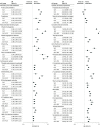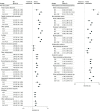Association Between Drug Use and Subsequent Diagnosis of Lupus Erythematosus
- PMID: 32876672
- PMCID: PMC7489398
- DOI: 10.1001/jamadermatol.2020.2786
Association Between Drug Use and Subsequent Diagnosis of Lupus Erythematosus
Abstract
Importance: It has been estimated that up to 30% of all subacute cutaneous lupus erythematosus (CLE) cases and up to 15% of systemic lupus erythematosus (SLE) cases are drug induced. Based on numerous case reports and several epidemiologic studies, more than 100 drugs from more than 10 drug classes are suspected to cause drug-induced lupus erythematosus.
Objective: To examine the association between drug use and a subsequent diagnosis of CLE or SLE based on a systematic screening process of the drugs in the Anatomical Therapeutic Chemical classification system in a nationwide setting.
Design, setting, and participants: A matched case-control study was conducted using all incident cases of CLE and SLE registered in the Danish National Patient Register between January 1, 2000, and December 31, 2017. Patients with CLE and patients with SLE were matched (1:10) on age and sex, with individuals from the general population serving as controls.
Exposures: To select which drugs to examine for an association with CLE or SLE, a screening process of all drugs was performed, including drugs filled at pharmacies and drugs administered in hospitals.
Main outcomes and measures: Odds ratios (ORs) were calculated for the association between exposures to certain drugs and the subsequent diagnosis of CLE or SLE.
Results: In all, 3148 patients with CLE (n = 1298; 1022 women [78.7%]; median age at diagnosis, 50.5 years [interquartile range, 39.4-62.2 years]) or SLE (n = 1850; 1537 women [83.1%]; median age at diagnosis, 45.0 years [interquartile range, 33.6-56.4 years]) and 31 480 controls (25 590 women [81.3%]; median age, 47.5 years [interquartile range, 35.9-59.5 years]) were found. Many significant associations between drug use and a subsequent diagnosis of CLE and SLE were observed. Many associations were likely due to protopathic bias. However, new plausible causal associations were observed between CLE or SLE and some drugs, including fexofenadine hydrochloride (SLE: OR, 2.61 [95% CI, 1.80-3.80]; CLE: OR, 5.05 [95% CI, 3.51-7.26]), levothyroxine sodium (SLE: OR, 2.46 [95% CI, 1.97-3.07]; CLE: OR, 1.30 [95% CI, 0.96-1.75]), metoclopramide hydrochloride (SLE: OR, 3.38 [95% CI, 2.47-4.64]; CLE: OR, 1.47 [95% CI, 0.85-2.54]), and metronidazole hydrochloride (SLE: OR, 1.57 [95% CI, 1.09-2.27]; CLE: OR, 1.93 [95% CI, 1.25-2.97]).
Conclusions and relevance: The study's findings suggest that physicians should be cognizant about whether a new case of CLE or SLE could be drug induced. Furthermore, the results highlight that the reported associations in the published literature may be due to publication or protopathic bias.
Conflict of interest statement
Figures



References
MeSH terms
Substances
LinkOut - more resources
Full Text Sources
Medical

